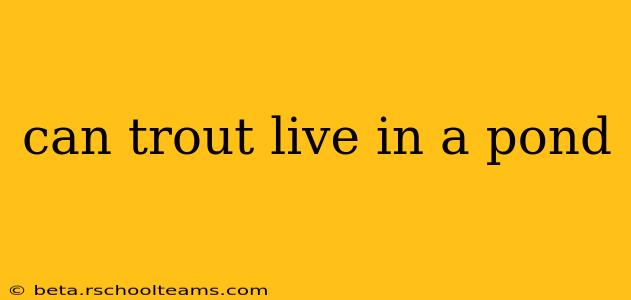Can Trout Live in a Pond? A Deep Dive into Trout Habitat
The question of whether trout can live in a pond is more nuanced than a simple yes or no. While trout can technically survive in a pond under certain specific conditions, it's not their ideal habitat, and success is far from guaranteed. This article explores the factors that determine whether a pond is suitable for trout, addressing common concerns and misconceptions.
What kind of water do trout need?
Trout are cold-water fish, thriving in consistently cool, oxygen-rich water. This is the most crucial factor determining their survival in a pond environment. Unlike many other fish species, trout are highly sensitive to temperature fluctuations and low dissolved oxygen levels. Their ideal water temperature ranges from 45°F to 65°F (7°C to 18°C). Ponds, particularly smaller ones, are often more susceptible to temperature swings and oxygen depletion, especially during warmer months.
How big does a pond need to be for trout?
Pond size plays a significant role. Larger ponds offer a greater volume of water, which helps to mitigate temperature fluctuations and maintain consistent oxygen levels. A smaller pond will heat up and deplete oxygen much faster, potentially stressing or killing the trout. The size also influences the availability of suitable food and hiding places for the trout. Ideally, a pond suitable for trout would be quite large and deep, providing a stable environment.
What about oxygen levels in a pond?
Oxygen levels are critical. Trout require well-oxygenated water. In stagnant or heavily vegetated ponds, oxygen can become severely depleted, especially during periods of warm weather or algal blooms. These blooms can further reduce oxygen levels and release toxins harmful to trout. Regular testing of dissolved oxygen levels is crucial for ensuring the pond is suitable for trout.
What kind of food do trout need in a pond?
A healthy pond ecosystem is essential for providing trout with an adequate food source. They primarily feed on insects, crustaceans, and smaller fish. The pond should be stocked with appropriate invertebrates and smaller fish species to support a thriving trout population. Lack of adequate food can lead to stunted growth and increased vulnerability to disease.
Can you stock trout in a pond that already has other fish?
Introducing trout to a pond already populated with other fish species requires careful consideration. Trout might compete with existing fish for resources, or even become prey themselves, especially if larger predatory fish are present. The existing ecosystem’s balance should be thoroughly assessed before introducing trout.
What are the challenges of keeping trout in a pond?
Keeping trout in a pond presents several challenges:
- Temperature fluctuations: Ponds are susceptible to temperature changes, potentially exceeding the trout's tolerance.
- Oxygen depletion: Stagnant water or algal blooms can lead to dangerously low oxygen levels.
- Lack of suitable food: The pond might not support a sufficient food chain to sustain a healthy trout population.
- Predation: Existing fish populations or other predators might prey upon the trout.
- Disease: Stress from unfavorable conditions can increase susceptibility to disease.
Conclusion:
While it's possible to keep trout in a pond, it's a challenging undertaking requiring careful planning and ongoing monitoring. The pond must be large enough, consistently cool, well-oxygenated, and have a suitable food web. Without meeting these stringent conditions, the likelihood of trout survival is low. Thorough research and expert advice are essential before attempting to establish a trout population in a pond.
